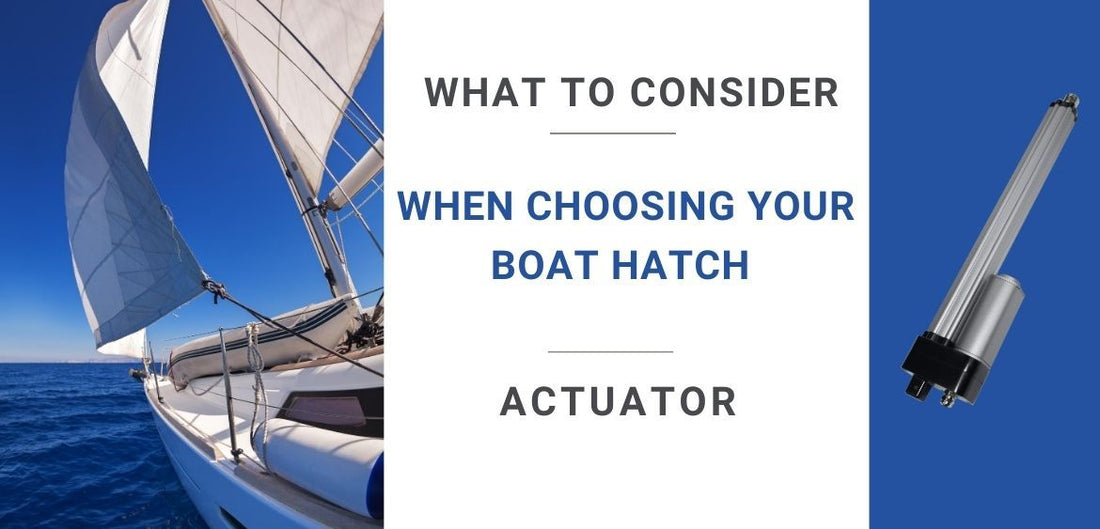Boat hatch actuators serve a critical role on marine vessels as they keep the environment from reaching sensitive areas, be it the living quarters or mechanical and electronic equipment. These hatches tend to be heavy due to the nature of their function and as such, it is often difficult to open them by hand when required, especially in choppy waters. This article will explore how to automate the boat hatch with a linear actuator and what factors you should consider when making your actuator purchase decision, ensuring quick and easy access to any area on the boat that is separated by a hatch.
Factors for Choosing an Actuator
There are many factors to consider when choosing the correct boat hatch actuator. We have listed and briefly discussed the most pertinent below, ensuring you get a comprehensive overview of what you need to consider prior to implementation.
Weight of the Hatch
Firstly, the weight of the hatch needs to be determined. This can be estimated but it would be far more accurate and effective to unscrew the hatch and weigh it on a bathroom scale or hang it from a fishing scale. If the goal is to get a replacement actuator for a boat hatch, then the load on the original actuator can be used as a starting point for the new and improved one.
Length & Width of Hatch
The physical dimensions of the hatch will determine the length of the actuator required. For instance, if the hatch is long, then an actuator with increased stroke will be needed in order to completely open the hatch.
Mounting Locations
It is important to note any possible mounting locations. Never mount a single actuator on one side of a hatch. When the hatch is pushed open the boat hatch lift actuator imparts a twisting force onto the opposite hinge. Over time this can cause the hinges to fail.
Alternatively, if only one actuator is used it must be placed in the center of the hatch if practical to limit any twisting forces. This arrangement will however not be ideal for a boat engine hatch lift actuator, which will require unimpeded access to the engine. The force required to open the hatch decreases towards the end of the hatch while the stroke length increases. Conversely, the force required to open the hatch increases towards the hinge while the stroke decreases. This is shown by the blue arrows in the figure below. It is therefore important to strike a balance between stroke length and actuator force. Luckily, a wide range of actuators is available that fit any application.

It is also important to note that the mounting location needs to be strong enough to take the weight of the hatch. This can be accomplished with compatible mounting brackets for the linear actuator of your choice.

Speed of Actuation
This is not as critical a point, especially regarding a linear actuator for a boat engine hatch which is not opened regularly. However, it must be noted that an actuator slows down with increased load as per the graph below. Therefore, if fast actuation is required then a slightly overpowered actuator may be required in order to achieve higher speeds at high loads. For example, the PA-09 has different speed ranges at different loads with the highest speeds present at very low loads.

Power Supply
The electrical supply available on the boat needs to be determined, i.e. is it 12V or 24V DC? Actuators can be supplied for different voltages and therefore this needs to be specified.
Environmental Conditions
The location of the boat hatch lift actuator is important as it will determine what level of environmental protection is required for the actuator. If the hatch is on the deck of the boat, then it will be exposed to spray and will need a higher IP rating. If the boat will encounter salt water, then it is critical to select an actuator that has a high IP rating that can also withstand highly corrosive saltwater spray.
Calculating the Force of the Actuator
Once all the above factors have been determined, the force of the actuator for your boat hatch can be estimated. In order to determine what size actuator is required, the maximum force must be calculated. This can be done by drawing a simple free body diagram to visualize all the forces acting on the actuator.
To simplify the calculation, only the worst-case scenario is considered, i.e. when the hatch is in its closed position. This is because as the hatch opens, its weight is increasingly taken up by the hinge and therefore the actuator requires less force to push the hatch open.

Assuming the door is in the closed position the actuator force Fc can be determined by calculating the moments around point B. The free-body diagram for the closed hatch position is shown below.

Simplified the y-component of the actuator force is equal to the weight of the lid multiplied by the length ratio between the applied force and the gravitational force.

In order to calculate the required actuator force, Fc, the y-component and angle, theta, must be used as per the force triangle below.


The equation for Fc below can be used to determine the actuator force required to open a boat hatch with an initial angle theta and mounting location of L1.

In Conclusion
Whether you are planning to install a brand-new boat hatch lift actuator, or some damage has made it necessary to source a replacement actuator for your boat hatch, by carefully following the above factors it should be a seamless experience. The considerations outlined above can all be addressed with our extensive catalog of electric linear actuators and our in-house engineers would love to help with queries outside the scope of this article.
Contact us with these queries and we will aim to get back to you ASAP!




